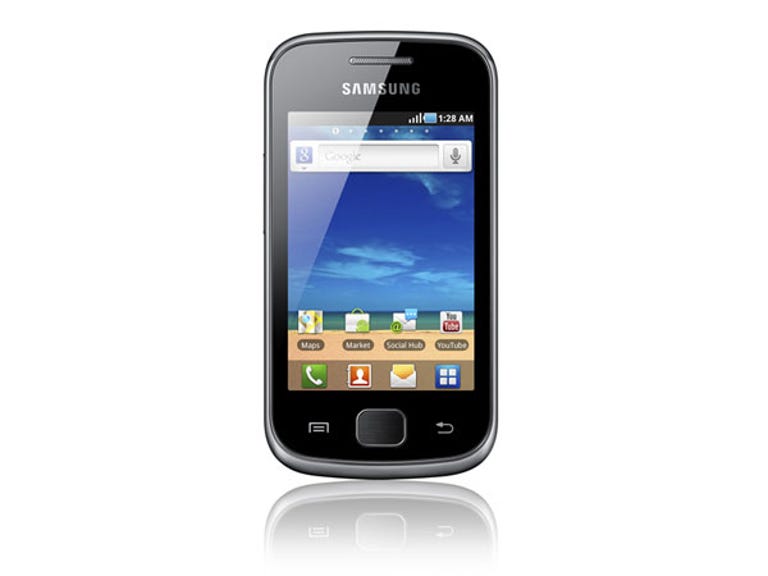 Why You Can Trust CNET
Why You Can Trust CNET Samsung Galaxy Gio review: Samsung Galaxy Gio
The Samsung Galaxy Gio is outstanding value for money, basically delivering last year's best smartphone experience in a cheaper, affordable package.
Design
Across the range of smartphones in Australia, the trend is towards lower prices for the top-tier devices, but how does this affect the pre-paid segment? Happily, while pre-paid handset prices remain fairly static, the quality of the handsets at this price point is on the up. The Galaxy Gio is an excellent example of this; for AU$149 (locked to the Optus network), you get a far better phone than the phones in this price range last Christmas.
The Good
The Bad
The Bottom Line
The Gio is solidly designed, although its frame is constructed entirely from plastic, and Samsung retains the good looks of its more expensive handsets. A faux-steel rim surrounds the edge of the Gio, and we like the dimpled texture across the battery cover.
The screen doesn't sound great on paper; we've criticised other phones with 3.2-inch HVGA displays recently, but this screen appears to be noticeably easier to read than the others, and the colours looks vibrant, too. Off-axis viewing can be troublesome, but, for most daily smartphone use, this screen will do just fine.
The handset includes the range of ports and slots that we saw on phones 12 months ago, with a single micro-USB port for charging and data transfers, a dedicated 3.5mm headphone socket and a microSD card slot handily located on the right-hand side of the phone. There's no camera button (you use software buttons to take photos), and no HDMI port — but then, we wouldn't expect that in an AU$150 phone.
User experience
Probably the best part of this pre-paid package is that Samsung basically delivers the same user experience that you get in last year's top-end Galaxy S smartphone, but for a fraction of the price. Samsung's TouchWiz UI is employed here, which gives you seven home screens to customise with widgets and a clean, horizontally scrolling apps drawer, which is really easy to navigate quickly.
Features
When you're browsing pre-paid smartphones, it's common to wonder, "what doesn't this phone have?" rather than looking for what's included. Impressively, this list is rather short. The Gio supports 3G browsing on the Optus network (900 and 2100Mhz UMTS frequencies), Wi-Fi, GPS and Bluetooth. Samsung includes social networking apps and Navigon maps out of the box, plus DLNA media sharing, so you can share pictures, music and video with a compatible TV or Blu-Ray/DVD player over Wi-Fi.
There's also a 3-megapixel camera included in this package, with auto-focus software and a range of scene modes, smile detection and a panorama shooting mode. There's no flash for illuminating dark scenes, so you'll want to avoid nightclubs with the Gio, but otherwise the photos are reasonably good.
The Gio runs on Android Froyo version 2.2, and although this is a few generations older than the latest Android systems, we haven't noticed any major downsides during our tests. With 2.2, you have the ability to create a Wi-Fi hotspot and share your 3G data with a computer or tablet, and speech-to-text functionality for creating text messages and emails without typing. Samsung also improves keyboard input by including Swype software, allowing you to compose messages with continuous swiping gestures rather than tapping at the screen.
Performance
For AU$149, we can't say that we expected too much performance out of this pre-paid handset, so we were extremely impressed with what we discovered when using the Gio. This user experience is extremely punchy for a phone with an 800MHz processor. Samsung has done a great job of stripping back its system to its leanest, and the result is an extremely responsive system that reacts to input immediately. Turning the phone on, jumping to menus, scrolling across pages of apps — all of the daily tasks happen without any delay or any stuttering in the animation.
Battery life is good, but not remarkable in any way. The handset's 1350mAh capacity battery is generous for a phone of this size, but, with regular use of the internet, email and social networks, we found that we charged the Gio every second day.
Overall
If you're looking to dodge a carrier contract and have AU$200 to spend on a phone, we highly recommend the Galaxy Gio. It's 3.2-inch display is better than its rivals, and the performance of this system is outstanding. It runs an older version of the Android OS than most other phones in the market at this time, but this doesn't hold it back in any way that we could find. The Galaxy Gio is outstanding value for money.


